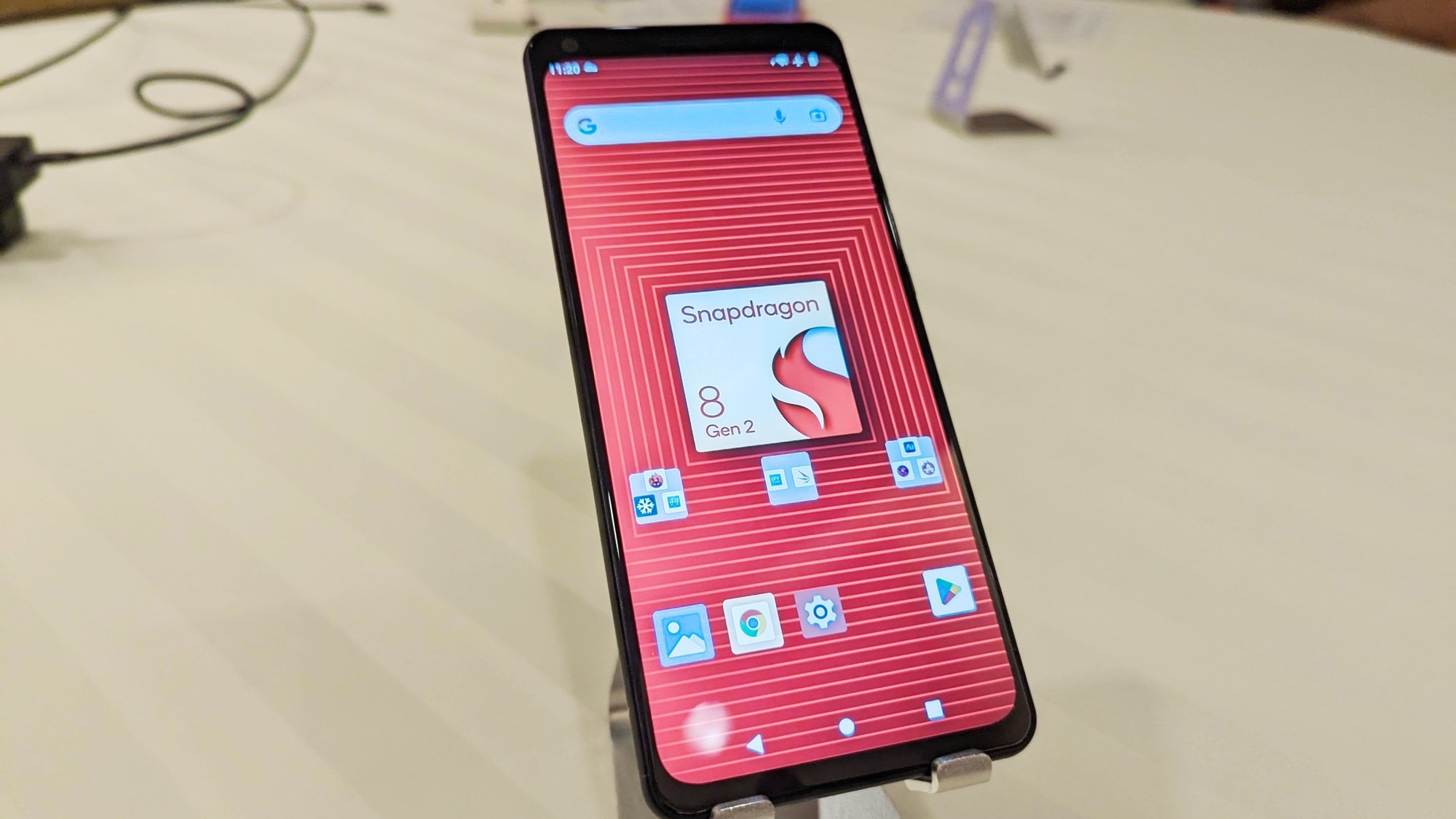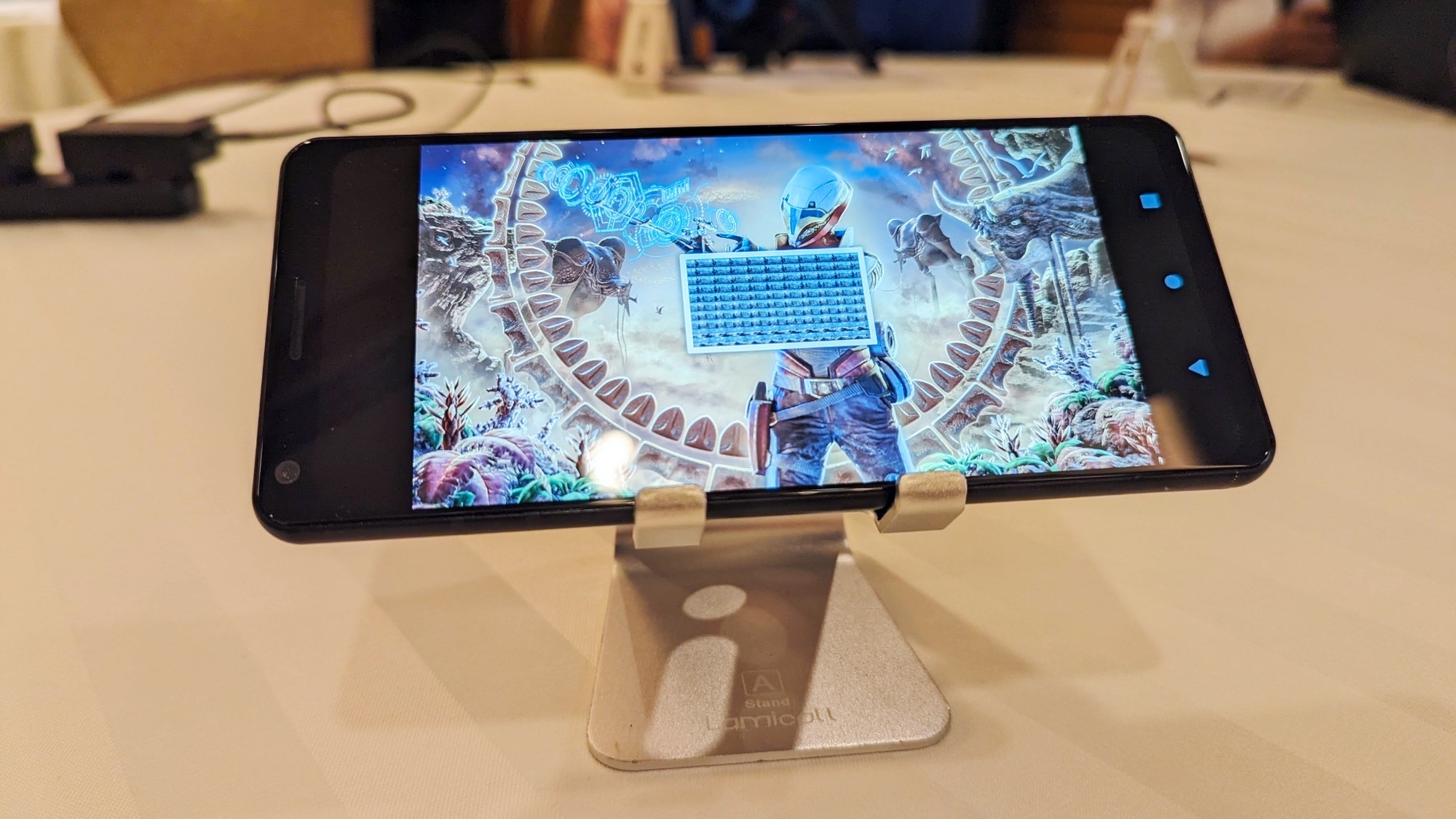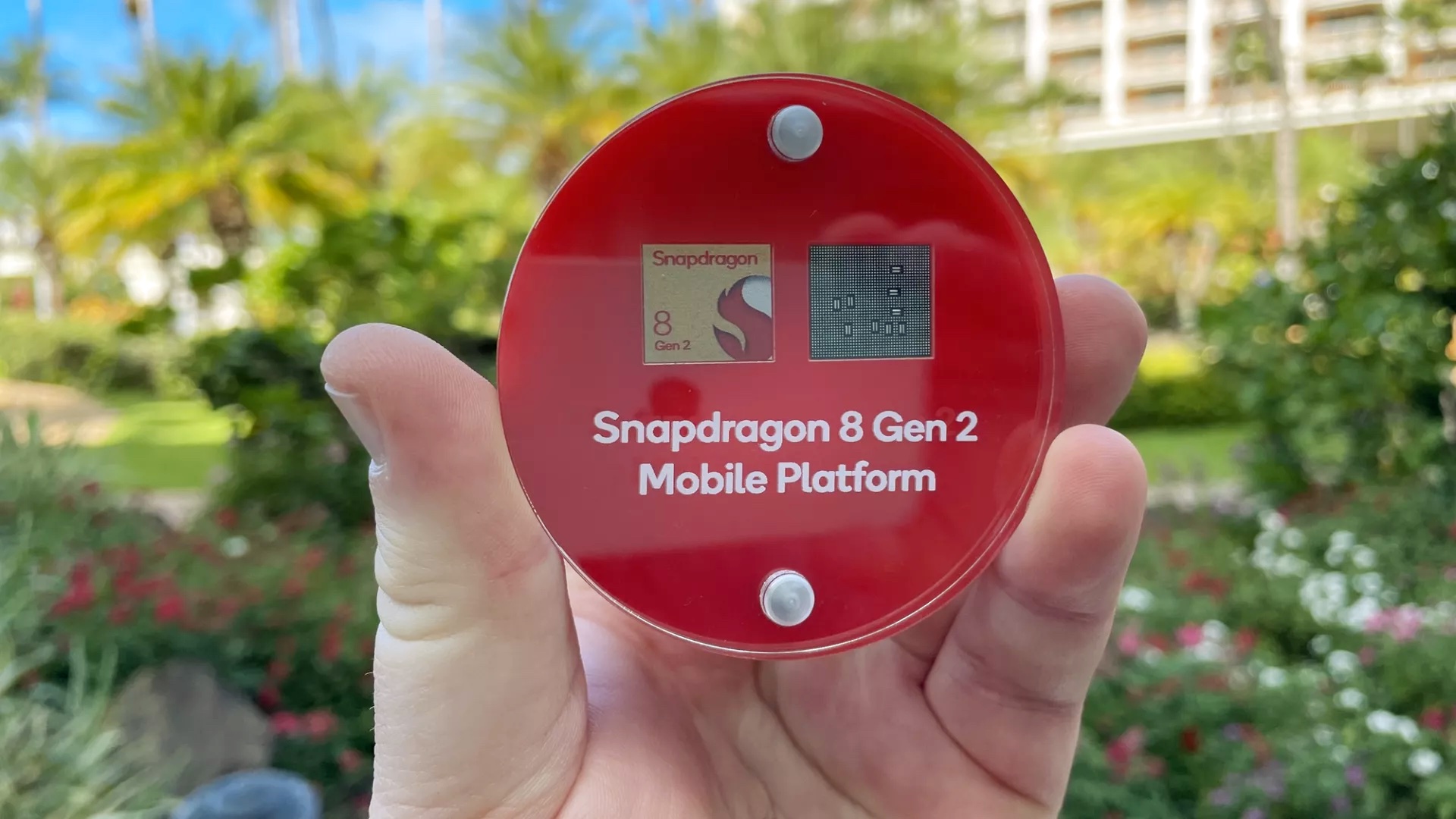Snapdragon 8 Gen 2 benchmarks — the iPhone 14 should be worried
In our testing, Qualcomm's new chip puts up some impressive numbers

Apple's reign as the maker of top performing mobile chips looks like it's going to continue into 2023. But Qualcomm's Snapdragon 8 Gen 2 system-on-chip outmuscles the older A15 Bionic in many benchmarking tests and gets close to the A16 Bionic in others — uncomfortably so, if you're reading this in Cupertino.
Qualcomm unveiled the Snapdragon 8 Gen 2 at its annual Snapdragon Summit last week, and as a guest of the chip maker, I got the chance to run some benchmarks on the new silicon along with other members of the tech press in attendance.
The results I saw look like good news for anyone planning on buying a flagship Android phone next year, as the Snapdragon 8 Gen 2 is expected to power many of the best Android phones — including the Samsung Galaxy S23 lineup.
Regardless of which phone the Snapdragon 8 Gen 2 winds up in, you can expect big gains in performance over current Android devices, at least based on the benchmarks we had the chance to run. In particular, the new chipset's performance in graphics benchmarks suggest this will be a great addition to the best gaming phones coming out in the next year.
For its part, Qualcomm emphasizes other Snapdragon 8 Gen 2 benefits, such as enhancements to its AI Engine and image image signal processor, the latter of which should fuel a number of camera improvements on upcoming phones. "Our goal is to create extraordinary experiences," said Shahin Farahani, senior director of product management at Qualcomm. "Benchmarks are a side effect to experiences."

For our testing, we used a reference design device supplied by Qualcomm that's powered by a Snapdragon 8 Gen 2 system-on-chip. To put the results we got in context, we're posting our own test results conducted as part of our phone reviews of top flagship devices released in the past year.
That includes the Galaxy S22 Ultra, which runs on the Snapdragon 8 Gen 1, as well as the Galaxy Z Fold 4 and its slightly faster Snapdragon 8 Plus Gen 1 chipset. We're also comparing numbers from two recent iPhones — the iPhone 14 Pro Max and iPhone 14, which run on different chipsets. (Apple uses the older A15 Bionic in the standard iPhone, while Pro models gets a boost from the A16 Bionic silicon.) Rounding out our test devices, we're including the Pixel 7 Pro and its Google-designed Tensor G2 processor.
Sign up to get the BEST of Tom's Guide direct to your inbox.
Get instant access to breaking news, the hottest reviews, great deals and helpful tips.
Snapdragon 8 Gen 2: CPU and GPU changes
Before diving into the Snapdragon 8 Gen 2 benchmark results, let's take a look at some of the changes Qualcomm made to the CPU and GPU and how that's expected to impact performance.

The Kryo CPU on the Snapdragon 8 Gen 2 uses a 3.2GHz prime core. Qualcomm added an extra performance core for this version of its CPU for a total of four, while there are three efficiency cores. Qualcomm expects its CPU to be 35% faster than the one on the Snapdragon 8 Gen 1, while power efficiency is expected to improve by 40%. (We're particularly excited by that latter promise, as the battery life of Snapdragon 8 Gen 1-powered phones didn't really impress.)
As for the Adreno GPU, it's the first to offer Vulkan 1.3 support as well as a Snapdragon Game Post Processing Accelerator. It supports real-time hardware-accelerated ray tracing, too. Qualcomm says that should lead to a 25% boost in performance and 30% Vulkan uplift over the Snapdragon 8 Gen 1. GPU power efficiency is expected to rise by 45%, too.
The reference design device we tested featured 12GB of LPDDR5X RAM. The handset also sported a 6.8-inch AMOLED panel with FHD+ resolution and a 144Hz refresh rate.
Snapdragon 8 Gen 2: Overall performance
To measure overall performance, we run the Geekbench 5 benchmark. Traditionally, Apple's phones dominate this test, and while the Snapdragon 8 Gen 2 doesn't change that overall dynamic, the margin of victory for Apple's A series of mobile silicon is shrinking.
| Phone | Processor | Geekbench 5 single-core score | Geekbench 5 multicore score |
| Qualcomm Snapdragon 8 Gen 2 Reference Design | Snapdragon 8 Gen 2 | 1,500 | 5,249 |
| Samsung Galaxy S22 Ultra | Snapdragon 8 Gen 1 | 1,240 | 3,392 |
| Apple iPhone 14 Pro Max | A16 Bionic | 1,882 | 5,333 |
| Apple iPhone 14 | A15 Bionic | 1,727 | 4,553 |
| Google Pixel 7 Pro | Tensor G2 | 1,060 | 3,046 |
| Samsung Galaxy Z Fold 4 | Snapdragon 8 Plus Gen 1 | 1,328 | 3,831 |
The Snapdragon 8 Gen 2-powered reference design device Qualcomm gave us averaged a single-core score of 1,500, which topped the Snapdragon 8 Gen 1 inside the Galaxy S22 Ultra by 21%. That single-core score was also better than the Galaxy Z Fold 4's 1,328 result, and that foldable phone ran on a newer Snapdragon 8 Plus Gen 1.
The iPhone 14 models retain their single-core score lead, no matter if you have a handset running the A15 Bionic or A16 Bionic. The iPhone 14 has a single-core result of 1,.727 on Geekbench, while the iPhone 14 Pro Max boosts that number to 1,882.
It's the multicore test on Geekbench where the Snapdragon 8 Gen 2 makes its biggest strides. Its 5,249 result bests the numbers put up by the Galaxy S22 Ultra (3,392) and Galaxy Z Fold 4 (3,831) as you'd expect, but it's also better than the iPhone 14's 4,553 result. The iPhone 14 Pro Max continues to post the best result here, with a 5,333 score, but the gap is clearly narrowing.
We typically don't run the Antutu benchmark as it doesn't produce valuable comparisons between Android and iOS devices. However, it can show how performance improves from one generation of chip to the next. On my Snapdragon 8 Gen 2 test device, I recorded a score of 1,272,036 in Antutu. That's 46% better than the score I got when I ran that same test on a standard Galaxy S22 I had. The Snapdragon 8 Gen 2 feels like a big leap forward over the silicon in last year's phones.
Snapdragon 8 Gen 2 benchmarks: Graphics
The graphical changes Qualcomm made with the Snapdragon 8 Gen 2 really seem to have paid off, at least in our benchmark results. In our favorite test — 3DMark's Wild Life Unlimited — the Snapdragon 8 Gen 2-powered device posted the best results, even beating the iPhone.
| Phone | Processor | 3DMark Wild Life Unlimited (FPS) | 3DMark Wild Life Extreme Unlimited (FPS) |
| Qualcomm Snapdragon 8 Gen 2 Reference Design | Snapdragon 8 Gen 2 | 84 | 22.4 |
| Samsung Galaxy S22 Ultra | Snapdragon 8 Gen 1 | 56.9 | 14 |
| Apple iPhone 14 Pro Max | A16 Bionic | 74 | 19.9 |
| Apple iPhone 14 | A15 Bionic | 69.1 | 15.5 |
| Google Pixel 7 Pro | Tensor G2 | 40.3 | 10.8 |
| Samsung Galaxy Z Fold 4 | Snapdragon 8 Plus Gen 1 | 52.8 | 16 |
We recorded an 84 frames per second score for the Snapdragon 8 Gen 2 phone, ahead of the iPhone 14 Pro Max's 74 fps result. The performance was also a 48% improvement over the Galaxy S22 Ultra's 56.9 fps result, so it looks like a big gain from the Snapdragon 8 Gen 1.
Likewise, in the more demanding Wild Life Extreme Unlimited test, the Snapdragon 8 Gen 2's 22.4 fps result was ahead of both the iPhone 14 Pro Max (19.9 fps) and iPhone 14 (15.5).
| Phone | Processor | GFXBench 1080p T-Rex (offscreen) score | GFXBench 1440p Aztec Ruins Vulkan (High-Tier Offscreeen) score |
| Qualcomm Snapdragon 8 Gen 2 Reference Design | Snapdragon 8 Gen 2 | 481 | 65 |
| Samsung Galaxy S22 | Snapdragon 8 Gen 1 | 412 | 42 |
| Apple iPhone 14 | A15 Bionic | 457 | 46.7 |
| Google Pixel 7 | Tensor G2 | 306 | 33 |
Just to see if these results held out in other graphics benchmarks, I download the GFXBench app onto some devices I had on hand — the iPhone 14 and Pixel 7 in addition to the Galaxy S22 — comparing their numbers to what I recorded with Snapdragon 8 Gen 2 test unit.
In the off-screen 1080p T-Rex test on GFXBench, the Snapdragon 8 Gen 2 posted a result of 481 fps, beating the iPhone 14 (457 fps) and Galaxy S22 (412 fps); the Pixel 7 trailed all three phones with a 306-fps result.
Similarly, on the offscreen 1440p Aztec Ruins test for Vulkan, the Snapdragon 8 Gen 2's 65 fps score was nearly double what the Pixel 7 produced and well ahead of the 42 fps result for the Galaxy S22. (Note that the iOS version of GFXBench doesn't break out the Aztec Ruins tests into Vulkan and Open GL versions, but the iPhone 14's score of 46.7 fps on the 1440p Aztec Ruins test also trailed the Snapdragon 8 Gen 2.)
Snapdragon 8 Gen 2 benchmarks: Adobe Premiere Rush
In addition to synthetic benchmarks, we like to throw a real-world test at mobile chipsets to see how well they handle the kind of tasks you'd use your phone to run on a daily basis. In our case, we take a 4K video and transcode it using Adobe Premiere Rush, timing the results.
| Phone | Processor | Adobe Premiere Rush result (Mins:Secs) |
| Qualcomm Snapdragon 8 Gen 2 Reference Design | Snapdragon 8 Gen 2 | 0:37 |
| Samsung Galaxy S22 Ultra | Snapdragon 8 Gen 1 | 0:47 |
| Apple iPhone 14 Pro Max | A16 Bionic | 0:30 |
| Apple iPhone 14 | A15 Bionic | 0:28 |
| Google Pixel 7 Pro | Tensor G2 | 0:47 |
| Samsung Galaxy Z Fold 4 | Snapdragon 8 Plus Gen 1 | 0:45 |
The Snapdragon 8 Gen 2 test device turned in the best result we've ever seen on an Android phone, completing the task in 37 seconds. That's 10 seconds faster than what the Pixel 7 Pro and Galaxy S22 Ultra could do, and 8 seconds ahead of one of our previous Android pace-setters, the Galaxy Z Fold 4.
Even with that gain, though, Snapdragon 8 Gen 2 phones are likely to continue playing second fiddle to the iPhone, even with the iPhone 14 Pro Max turning in a surprising result in that test. (Strangely, Apple's best phone doesn't turn in the best time here.) The iPhone 14 (28 seconds) and iPhone 14 Pro Max (30 seconds) both beat the Snapdragon 8 Gen 2, though Qualcomm's chipset is within 10 seconds of beating those handsets.
Snapdragon 8 Gen 2 benchmarks: Overall impressions
Benchmarks for actual phones shipping with Snapdragon 8 Gen 2 could wind up being different from the numbers I recorded with this test device. Different phones can be optimized in different ways, depending on what kind of experience a phone maker wants to deliver. But these numbers still give us a pretty good idea of what to expect from Snapdragon 8 Gen 2-powered phones — and there's a lot to look forward to.
Qualcomm's new silicon seems like it's ideal for gaming or any other tasks that relieves heavily on intense graphics. And while the iPhone maintains its lead in some key tests, the gap is narrowing — an important thing to keep in mind, given that Apple is rumored to be sticking with the strategy of putting different chips in its Pro phones and standard model with 2023's iPhone 15 lineup.
So Snapdragon 8 Gen 2 phones should be among the top-performing devices coming out in the next year. We've never been more excited to see what that translates to in a phone that's available for purchase.
Updated to provide additional details about Qualcomm's reference design device used in benchmarking.
Philip Michaels is a Managing Editor at Tom's Guide. He's been covering personal technology since 1999 and was in the building when Steve Jobs showed off the iPhone for the first time. He's been evaluating smartphones since that first iPhone debuted in 2007, and he's been following phone carriers and smartphone plans since 2015. He has strong opinions about Apple, the Oakland Athletics, old movies and proper butchery techniques. Follow him at @PhilipMichaels.

